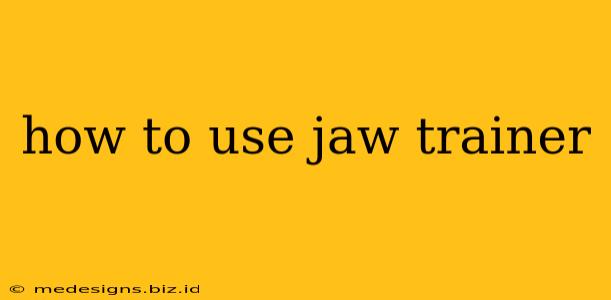Are you looking to improve your jawline, reduce TMJ pain, or simply enhance your facial aesthetics? A jaw trainer, also known as a jaw exerciser, might be the solution you're looking for. But how exactly do you use one effectively and safely? This comprehensive guide will walk you through everything you need to know.
Understanding Your Jaw Trainer
Before diving into the exercises, it's crucial to understand your specific jaw trainer. Different models offer varying levels of resistance and functionality. Some are designed for simple exercises, while others incorporate more advanced techniques. Always refer to the manufacturer's instructions that came with your specific device. This guide provides general advice; specific instructions might vary.
Types of Jaw Trainers
Several types of jaw trainers exist, including:
- Ball-type: These usually involve a ball that you bite down on and roll around with your jaw.
- Bar-type: These feature a bar that you bite down on, providing resistance for various jaw movements.
- Electric stimulators: These use electrical impulses to stimulate jaw muscles.
Each type requires slightly different techniques.
Basic Jaw Trainer Exercises
Once you're familiar with your jaw trainer, start with these basic exercises. Remember to start slowly and gradually increase the intensity and duration as your jaw muscles strengthen. Overdoing it can lead to soreness and injury.
Exercise 1: Simple Bites
This is a great starting point. Simply bite down on your jaw trainer with a comfortable force and hold for a few seconds. Repeat this several times. Focus on maintaining a relaxed posture and avoiding clenching your teeth too hard.
Exercise 2: Jaw Circles
Gently bite down on the jaw trainer and slowly rotate your jaw in a circular motion. Perform several rotations clockwise and then counterclockwise. Maintain a slow, controlled pace to avoid strain.
Exercise 3: Side-to-Side Movements
With the jaw trainer in place, move your jaw gently from side to side. Focus on smooth, controlled movements. Avoid any jerky or abrupt motions.
Exercise 4: Resistance Exercises (if applicable)
Some jaw trainers offer adjustable resistance. Gradually increase the resistance as your jaw muscles become stronger. Always listen to your body and stop if you experience pain.
Advanced Jaw Trainer Techniques
Once you've mastered the basics, you can explore more advanced techniques to challenge your jaw muscles further. These may include:
- Isometric holds: Holding the jaw trainer in a specific position for an extended period.
- Dynamic movements: Incorporating more complex jaw movements, such as diagonal movements or figure-eight patterns.
- Combining with other exercises: Incorporating jaw trainer exercises into a broader fitness routine.
Remember to consult with a dentist or physical therapist before attempting advanced techniques, especially if you have any pre-existing jaw conditions.
Safety Precautions
- Start slowly: Begin with short sessions and gradually increase the duration and intensity.
- Listen to your body: Stop if you experience any pain or discomfort.
- Maintain good posture: Keep your back straight and your shoulders relaxed while using the jaw trainer.
- Don't overuse it: Rest your jaw muscles between sessions.
- Clean your jaw trainer regularly: This helps prevent the buildup of bacteria and maintain hygiene.
- Consult a professional: If you have any concerns or pre-existing conditions, consult a dentist or physical therapist.
Frequently Asked Questions (FAQs)
Q: How long should I use a jaw trainer each day?
A: Start with short sessions (5-10 minutes) and gradually increase the duration as your muscles adapt.
Q: Will a jaw trainer make my face look slimmer?
A: While a jaw trainer can strengthen jaw muscles, its impact on facial appearance is variable and depends on individual factors.
Q: Can a jaw trainer help with TMJ?
A: Some people find that jaw trainers can help alleviate TMJ symptoms, but it's essential to consult a dentist or physical therapist for proper diagnosis and treatment.
By following these guidelines and using your jaw trainer consistently, you can work towards achieving your desired results safely and effectively. Remember, consistency and patience are key!
